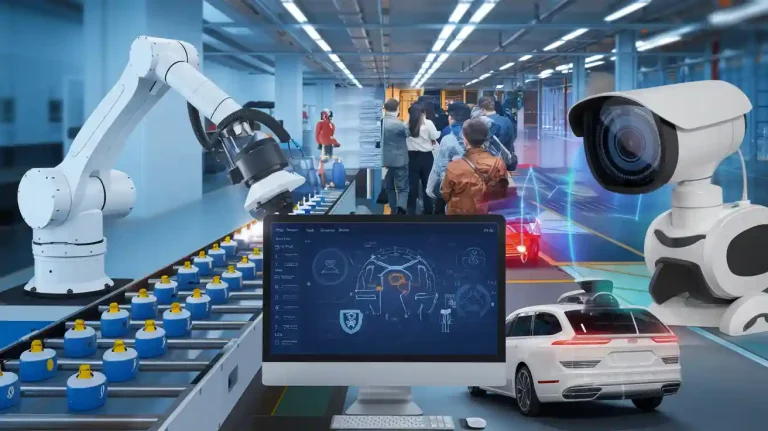The halcon machine vision system drives a new era of automation in industries worldwide. Companies across sectors rely on its flexible architecture for critical tasks in semiconductor inspection, quality control, and logistics.
Understanding the unique strengths of the halcon machine vision system helps automation professionals deliver reliable and scalable solutions.
| Attribute | Details |
|---|---|
| Market Size (2024) | USD 20.38 billion |
| Projected Market Size (2030) | USD 41.74 billion |
| CAGR (2025-2030) | 13.0% |
This rapid growth in machine vision shows its essential role in modern manufacturing and inspection.
Key Takeaways
- Halcon offers a flexible and powerful machine vision platform that supports advanced image processing, 3D vision, and deep learning to meet diverse industrial needs.
- The system integrates easily with various hardware and robotics, enabling faster, more accurate automation in manufacturing, quality control, and logistics.
- Halcon’s user-friendly development environment speeds up application creation and reduces costs, helping companies deploy reliable solutions quickly.
- Its deep learning tools simplify complex tasks like defect detection and object classification, improving inspection accuracy and reducing manual work.
- Continuous innovation in hardware and AI keeps Halcon at the forefront of machine vision, helping industries boost productivity and maintain high quality.
Halcon Machine Vision System
Overview
The halcon machine vision system stands as a standard software platform for industrial automation. It brings together hardware and software components to deliver reliable image acquisition and analysis. The system uses industrial cameras, specialized lenses, and lighting systems to capture high-quality images. Controllers and computing platforms process these images, while the software analyzes visual data for automation tasks. The modular architecture supports embedded smart cameras with customizable sensors and processors. This flexibility allows the halcon machine vision system to adapt to a wide range of industrial and medical imaging applications. The system supports multi-core platforms and GPU acceleration, making it suitable for demanding environments.
- Main Components of Halcon Machine Vision System:
- Industrial cameras for precise image acquisition
- Lenses and lighting for optimal image quality
- Controllers for processing image data
- Image processing software for analysis and automation
Core Capabilities
Halcon delivers a comprehensive library with over 2,100 operators for image acquisition, processing, and analysis. These operators support advanced tasks such as shape-based matching, 3D vision, and deep learning. The system enables users to customize and optimize machine vision solutions for unique automation needs. Developers can access the operator set through multiple programming languages, including Python. The architecture supports embedded and customized systems, multi-core platforms, and a wide range of industrial camera standards. Deep learning-based operators reduce manual programming for complex tasks like object detection and classification. This approach allows automation professionals to build robust solutions with less effort.
Halcon’s operator library empowers developers to create tailored machine vision applications that address specific industry challenges.
HDevelop Environment
The HDevelop environment serves as the integrated development environment for the halcon machine vision system. It enables rapid application development by providing tools for prototyping, debugging, and visualization. HDevelop supports image acquisition from various camera types and platforms, making it flexible for different projects. The environment offers features like autocompletion, easy image data visualization, and advanced debugging. These tools help developers save time and reduce costs during the development process. HDevelop also supports multi-threading and GPU acceleration, which boosts performance for complex image processing tasks. This environment gives automation professionals a competitive edge in building efficient and scalable machine vision solutions.
Key Features of Halcon
Image Processing
Halcon stands out as a comprehensive machine vision algorithm package. Its flexible architecture supports rapid development for many applications, including machine vision and image analysis. This flexibility allows engineers to create solutions faster and save costs. Halcon’s advanced image processing tools help users handle tasks like object detection, measurement, and defect identification with high accuracy. The software’s broad application scope makes it a preferred choice for industries that need reliable and adaptable image processing.
3D Vision
Halcon’s 3D vision technology brings several advantages to automation.
- Faster 3D matching improves speed and efficiency, even in scenes with many objects or edges.
- Automatic estimation of parameters increases reliability in challenging conditions, such as low contrast or high noise.
- Users do not need to set a viewpoint, which simplifies deployment.
- Advanced deep learning methods support robust edge detection.
- Support for multi-core platforms, GPU acceleration, and embedded systems ensures high performance.
- The system integrates with industrial standards like GenICam and GigE Vision, making it easy to use in many environments.
These features help automation systems recognize and match 3D objects quickly and reliably, even in complex or noisy settings.
Deep Learning
Halcon integrates deep learning into its machine vision solutions. The software uses methods like instance segmentation and anomaly detection to find defects and localize features with high accuracy. Engineers can train neural networks using mostly good images, which makes the process easier and faster. Halcon provides proprietary tools for labeling, training, and deploying models. This integration leads to automated, reliable inspections in industries such as automotive manufacturing. The system works in real time, connecting with cameras and PLCs to deliver immediate results. Halcon’s deep learning solutions offer seamless integration, high reliability, and professional support, making them superior to many open-source alternatives.
Hardware Compatibility
Halcon is hardware-independent and supports a wide range of imaging devices and sensors. It works with many camera types, including line scan, area scan, infrared, and stereo cameras. The software supports standard interfaces like GenICam, GigE Vision, and USB3 Vision. Halcon runs on ARM-based platforms with Linux, without needing custom porting. This compatibility allows developers to deploy applications on standard PCs, embedded systems, and smart cameras. The software’s support for embedded and edge computing platforms includes features like deep learning on CPUs, hardware acceleration, and easy evaluation tools. This flexibility helps users scale their systems, reduce costs, and future-proof their machine vision solutions.
| Feature | Description |
|---|---|
| Platform Compatibility | Runs on ARM-based embedded devices out-of-the-box |
| Interfaces Supported | GenICam, GigE Vision, USB3 Vision, Video4Linux, MIPI CSI, OPC UA |
| Deep Learning Support | Full functionality, optimized for embedded platforms |
| Hardware Acceleration | Supports AI inference accelerators |
| Development Tools | HDevelop programs run on embedded platforms |
| Evaluation Tools | HPeek demo program for performance checks |
| Flexibility | Wide device support and easy customization |
| Ease of Use | Ready-to-go download for ARM platforms |
MVTec Halcon in Automation
Industrial Applications
MVTec Halcon stands at the forefront of industrial automation. Manufacturers across the globe rely on its robust machine vision capabilities to solve complex challenges. The software powers a wide range of sectors, including semiconductor inspection, automotive, electronics, logistics, packaging, and robotics. Companies use mvtec halcon to detect defects, read barcodes, and perform optical character recognition for traceability. Production lines benefit from its ability to count and sort components, which streamlines workflow and reduces errors.
MVTec Halcon supports real-time monitoring and predictive maintenance. By integrating with 3D cameras, such as the SwissRanger SR4000, it enables high-resolution, real-time 3D object measurement. This feature expands its reach into robotics, life sciences, and packaging. The software’s flexibility allows it to adapt to demanding environments, making it a preferred choice for diverse industrial applications.
MVTec Halcon empowers industries to automate inspection, reduce labor costs, and achieve higher throughput with consistent quality.
Quality Control
Quality control remains a critical focus for manufacturers. MVTec Halcon transforms inspection processes by delivering automated, precise, and rapid measurement of micro and precision components. The software enables companies to move inspection tasks from clean rooms to production floors, which reduces inspection time and minimizes manual intervention. Shape-based 2D matching and subpixel thresholding algorithms provide sub-micrometer precision, ensuring that even the smallest defects are detected.
A table below highlights the measurable improvements mvtec halcon brings to quality control:
| Aspect | Description |
|---|---|
| Quality Control Improvement | Automated, highly precise, and fast inspection and measurement of micro and precision components. |
| Process Relocation | Measurement moved from clean rooms to production facilities, reducing inspection time and manual intervention. |
| Measurement Accuracy | Sub-micrometer precision achieved using advanced algorithms. |
| Optical Technology | Telecentric optics eliminate perspective distortion, enhancing measurement accuracy. |
| Automation | One-click measurement process with automatic detection and data transfer to quality control software. |
| Productivity Gains | Significant increase in throughput, enabling inspection of thousands of parts per minute. |
| Manual Intervention | Reduced to a minimum, improving efficiency and consistency. |
| Industry Application | Successfully applied in watchmaking and battery manufacturing for defect detection before labeling. |
| Measurable Results | Faster inspection times, seamless data integration, and robust, precise measurements under harsh conditions. |
Manufacturers in watchmaking and battery production have reported faster inspection times and seamless data integration. MVTec Halcon’s automation reduces manual labor and increases consistency, even in harsh production environments.
Robotics
Robotics automation depends on reliable vision systems. MVTec Halcon serves as a powerful image processing and machine learning library for robotics. It enables precise image acquisition, processing, and analysis, which are essential for tasks like pick-and-place, sorting, and assembly. In a notable case, Mission Design & Automation partnered with Michigan Brand to develop a custom mvtec halcon-based vision system for automating meat handling on a moving conveyor. The system integrates with FANUC robotic lines, allowing continuous, high-speed picking of meat pieces without stopping the conveyor.
Key features of this solution include duplicate detection, which selects optimal images for picking, and a first-in, first-out queue that ensures missed pieces can be picked by subsequent robots. This approach increased productivity by 50%. Engineers highlight mvtec halcon’s advantage in rapid development of reliable algorithms, which accelerates deployment and reduces downtime.
Robotic automation faces challenges such as recognizing chaotically arranged parts, coordinating robot and camera positions, and avoiding collisions. MVTec Halcon addresses these issues with advanced 3D point cloud processing, hand-eye calibration, and 3D object processing technology. The software selects parts that can be gripped safely, determines optimal gripping points, and manages container capacity to prevent workflow disruptions. These features enable safe, fast, and continuous automation, doubling process speed and relieving employees from repetitive tasks.
MVTec Halcon’s integration in robotics leads to measurable gains in efficiency, accuracy, and scalability, making it a cornerstone of modern automated production.
Future Trends
Innovation
Machine vision technology continues to evolve at a rapid pace. Companies now use advanced sensors, controllers, and lenses to capture sharper images and process data faster. For example, Omnivision’s 9MP global shutter CMOS sensor, launched in April 2024, sets a new standard for high-speed industrial imaging. Software also advances quickly. In November 2024, MVTec Software GmbH released HALCON 24.11, which introduced new artificial intelligence features. These features help users detect unexpected behavior in deep-learning classification tasks. The update shows how mvtec halcon leads the way in AI-driven machine vision software.
A comparison of recent innovations highlights the direction of the industry:
| Innovation Area | Details | Example | Impact on HALCON |
|---|---|---|---|
| Hardware Innovations | New sensors, actuators, controllers, lenses | Omnivision’s 9MP global shutter CMOS sensor (April 2024) | Complements software advances |
| Software Innovations | Enhanced image acquisition, AI-powered analysis, object recognition | HALCON 24.11 with AI for deep-learning classification (2024) | Keeps HALCON at the forefront of AI-driven software |
| Imaging Technology | Growth in 2D and 3D imaging, deep learning integration | 2D for inspection, 3D for depth and accuracy | HALCON supports both with continuous updates |
Artificial intelligence, especially deep learning, now allows mvtec halcon to solve problems that traditional methods cannot. Deep learning expands the system’s abilities, making it more adaptable and precise. Users can train models with synthetic data, improving efficiency and accuracy.
Industry Impact
The impact of these innovations reaches across many industries. Manufacturers use advanced machine vision to inspect products, read codes, and guide robots. HALCON’s deep learning features, such as Deep 3D Matching and improved OCR, help companies recognize objects and text faster and more accurately. These tools allow users to train models independently and generate synthetic training data from CAD models. New features like interruptible training and advanced camera integration make workflows more flexible.
Looking ahead, the technology roadmap for machine vision includes even more automation, smarter algorithms, and broader hardware support. Companies invest in research and development to create new solutions for complex tasks. As a result, mvtec halcon remains a key player in shaping the future of automation, helping industries achieve higher productivity and quality.
Halcon machine vision systems deliver several key strengths:
- Advanced 3D vision and shape-based matching for high-precision tasks
- Seamless robotics integration for pick-and-place and part alignment
- Flexible hardware and software support for many devices and standards
- Powerful deep learning tools that simplify programming and boost accuracy
- User-friendly development environments and strong professional support
Machine vision, powered by Halcon, increases productivity and reduces errors in industries such as logistics, battery inspection, and automotive manufacturing.
As automation evolves, Halcon will continue to drive innovation and set new standards for intelligent machine vision solutions.
FAQ
What industries use Halcon machine vision systems?
Halcon serves industries such as automotive, electronics, logistics, packaging, and life sciences. Companies use Halcon for inspection, measurement, and robotics. The software adapts to many environments and supports both large factories and small production lines.
How does Halcon support deep learning?
Halcon provides built-in tools for labeling, training, and deploying deep learning models. Engineers use these tools to detect defects, classify objects, and automate inspections. The system works with CPUs and GPUs for fast, accurate results.
Can Halcon run on embedded devices?
Yes, Halcon supports ARM-based embedded platforms. Developers can deploy machine vision applications on smart cameras and edge devices. The software offers ready-to-use downloads and hardware acceleration for efficient performance.
What makes Halcon different from other machine vision software?
Halcon offers a large library of operators, advanced 3D vision, and deep learning integration. The HDevelop environment speeds up development. Halcon supports many hardware types and standards, making it flexible for different automation needs.
Is Halcon easy to integrate with robotics?
Halcon integrates with major robot brands and controllers. Engineers use Halcon for pick-and-place, sorting, and assembly tasks. The software provides tools for calibration, object detection, and real-time control, making robotics automation faster and more reliable.
See Also
The Impact Of Machine Vision On Aerospace Production
Industries Being Changed By AI-Driven Vision Technologies
Essential Advantages And Features Of Vision Systems In Medicine
A 2025 Guide To Inspection Using Machine Vision Technology
Comparing Firmware-Based Vision With Conventional Machine Systems









